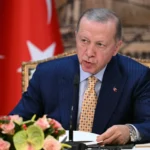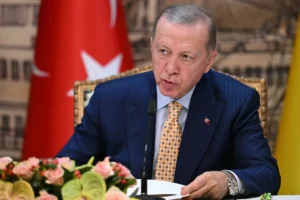Although the territorial sovereignty and maritime delimitation disputes between China and relevant parties in the South China Sea are difficult to resolve in the short term, China and ASEAN countries have always shared the same expectation for peace and stability in the South China Sea. The factors currently stirring up the tension in the South China Sea are relatively clear. The United States is trying to create regional division and confrontation through the “Indo-Pacific Strategy”. A series of security mechanisms and alliance partnerships targeting China have also made the South China Sea issue increasingly more geopolitical and military security.
On September 7, Jakarta, Indonesia, Indonesian President Joko held a press conference after the conclusion of the 43rd ASEAN Summit (Xinhua News Agency)
In recent years, the South China Sea issue has been the focus of ASEAN summits. On September 6, the ASEAN Secretariat issued the 43rd ASEAN Summit Chairman’s Statement, which also talked about the South China Sea issue.
Although the territorial sovereignty and maritime delimitation disputes between China and relevant parties in the South China Sea are difficult to resolve in the short term, China and ASEAN countries have always shared the same expectation for peace and stability in the South China Sea. The factors currently stirring up the tension in the South China Sea are relatively clear. The United States is trying to create regional division and confrontation through the “Indo-Pacific Strategy”. A series of security mechanisms and alliance partnerships targeting China have also made the South China Sea issue increasingly more geopolitical and military security.
Although ASEAN countries remain wary of taking sides in major power confrontations, the United States continues to strengthen alliances and hype up the China threat, intensifying geopolitical competition in the South China Sea and distracting ASEAN countries from cooperation in non-traditional security fields.
For a long time, the United States has been the country that dispatches the most warships and aircraft to the South China Sea, and is the country that holds the most frequent military exercises in the South China Sea. As the largest coastal country in the South China Sea, it is not only reasonable but also necessary for China to raise its own security concerns in response to this situation. On the other hand, in order to maintain regional peace and stability, ASEAN also needs to reflect on regional security issues, including how ASEAN’s own centrality and strategic autonomy should be reflected, and how ASEAN believes that countries outside the region should contribute to regional stability. What constructive role can it play?
The United States has repeatedly emphasized its support for ASEAN’s central status, but in fact what it has done is to maximize the “instrumental value” of ASEAN countries. The introduction of the “Quadrilateral Security Dialogue Mechanism” and the “U.S.-UK-Australia Trilateral Partnership” in Southeast Asia has actually weakened ASEAN’s dominant position in regional security cooperation.
Is the White House really out of respect for ASEAN’s centrality? Probably not. What they really want is to reshape the geopolitical environment around China. For example, under the framework of the Indo-Pacific Maritime Situational Awareness Initiative, the United States, Japan, and Australia are planning to conduct unmanned data collection in the South China Sea. Although the initiative nominally aims to enhance Southeast Asian countries’ capabilities to cope with climate change and fishery governance, its essence is It is to track and monitor China’s various maritime activities and build a comprehensive intelligence and reconnaissance network targeting China’s maritime activities to carry out “reconnaissance and deterrence” against China.
In the past few years, what the United States has done is to increase its investment in ASEAN under the framework of the “Indo-Pacific Strategy”, influence ASEAN countries in the political, diplomatic, economic, military and other fields, and try to include some ASEAN countries in the small group to contain and restrict China. circle. The most obvious one is to strengthen the alliance between the United States and the Philippines, and use disputes in the South China Sea to lure the Philippines into taking chestnuts from the fire in order to maintain the United States’ hegemony in the Western Pacific. Affected by this, the current speculative mentality of the Philippines on the South China Sea issue has become significantly stronger than in previous years.
Recently, the Philippines’ illegal transportation of construction materials to Ren’ai Reef in Nansha and China’s countermeasures have attracted attention. The Second Thomas Shoal issue is actually not a new issue, nor is it an issue between China and ASEAN. Its origins and historical background are clear.
If the Philippines tries to rely on ASEAN or the United States to put pressure on China, it will only make the situation more complicated and difficult to resolve. From the perspective of avoiding the escalation of the crisis, what the Philippines really needs to do is to enhance mutual trust with China and jointly create a positive political atmosphere instead of constantly hyping up maritime incidents.
Specifically, the Philippines should return to a series of consensuses reached with China on the management and control of disputes: first, maintain restraint on relevant disputes and refrain from taking actions that may aggravate the situation; second, insist on managing disputes through bilateral consultation mechanisms; The third is to persist in promoting practical maritime cooperation and joint development; the fourth is to prevent relevant disputes from affecting the healthy development of bilateral relations and the peace and stability of the South China Sea region.
ASEAN is understandably concerned about recent maritime developments. All parties recognize the importance of crisis management through the South China Sea Code of Conduct and the need to accelerate COC consultations. The purpose of the Code is not to impose solutions on disputing parties but to provide a crisis management approach to complex disputes.
In this sense, the COC should be based on the consensus of relevant countries to shelve disputes and for China and ASEAN countries to jointly maintain peace and stability in the South China Sea. If the “Guidelines” are to be legally binding, from the perspective of international law, the application of the document should be treated equally by all parties, and there should be no “double standards.” If the “norms” are not binding, from the perspective of international reality, appropriate political arrangements should allow all participating countries to feel that their concerns have been met or guaranteed.
Whether it is a legal document or a political document, the COC is ultimately an expression of the collective consciousness of China and ASEAN countries. The COC consultation cannot simply become a platform for individual countries to pursue their own interests, nor can it become a platform for any extraterritorial force to intervene in South China Sea affairs. geopolitical tool.
On September 6, 2023 local time, the 26th China-ASEAN (10+1) Leaders’ Meeting was held in Jakarta, Indonesia.
This year marks the 20th anniversary of China’s accession to the Treaty of Amity and Cooperation in Southeast Asia. Over the years of exchanges, China and ASEAN have upheld the East Asian concepts of mutual respect and consensus, accommodated each other’s concerns, enhanced mutual understanding and trust through sincere communication, and properly handled differences and disputes through seeking common ground while reserving differences.
Once the Cold War mentality returns and bloc confrontations take hold, the region’s hard-won peaceful development will inevitably face severe challenges, and the regional cooperation framework with ASEAN as its core will also be seriously eroded. In this regard, ASEAN countries and China need to strengthen unity, jointly resist external negative influences, and play a positive role in maintaining peace and stability in the South China Sea. (over)
Source : thepaper















